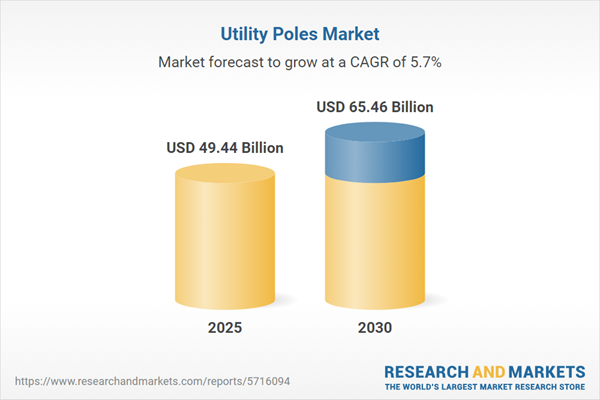Speak directly to the analyst to clarify any post sales queries you may have.
The utility poles market is evolving rapidly as operators respond to emerging technologies, regulatory changes, and heightened resilience requirements. Senior leaders face complex choices in specification and procurement that directly influence infrastructure reliability, cost-effectiveness, and sustainability.
Market Snapshot: Utility Poles Market Growth and Trends
The utility poles market grew from USD 46.85 billion in 2024 to USD 49.44 billion in 2025 and is projected to continue expanding at a CAGR of 5.73%, reaching USD 65.46 billion by 2030. This growth highlights increasing investment in grid modernization, urbanization, telecommunications networks, and infrastructure renewal. The adoption of advanced materials, coupled with operational and regulatory priorities, continues to reshape procurement approaches and asset management strategies across key regions.
Scope & Segmentation of the Utility Poles Market
- Material Types: Concrete (Prestressed, Reinforced), Fiberglass, Plastic, Steel, Wooden (Cedar, Pine, Redwood)
- Heights: Up to 10 Feet, 10–60 Feet, Above 60 Feet
- Load Capacities: Heavy, Medium, Light
- Coating Options: Coated, Uncoated
- Installation Types: New Installation, Replacement
- Applications: Electricity Transmission & Distribution, Signage & Communication (Advertising, Traffic Signal), Street Lighting (Rural, Urban), Telecommunications (Data Transmission, Telephone)
- End Uses: Commercial, Industrial, Residential
- Regions: Americas (United States, Canada, Mexico, Brazil, Argentina, Chile, Colombia, Peru), Europe, Middle East & Africa (including United Kingdom, Germany, France, Russia, Italy, Spain, Netherlands, Sweden, Poland, Switzerland, UAE, Saudi Arabia, Qatar, Turkey, Israel, South Africa, Nigeria, Egypt, Kenya), Asia-Pacific (China, India, Japan, Australia, South Korea, Indonesia, Thailand, Malaysia, Singapore, Taiwan)
Key Takeaways for Senior Decision-Makers
- Material innovation is driving longer asset life and expanded options beyond traditional timber, while requiring updated testing and specification processes.
- Digitization enables condition-based monitoring and remote inspections, facilitating optimized maintenance and asset replacement cycles.
- Climate resilience and regulatory initiatives are reshaping pole selection, with increasing attention to sustainability, safety, and recyclability in procurement criteria.
- Supply chain diversification is becoming integral to mitigate risks from tariffs and cross-border disruptions, requiring strategic supplier realignment and regional production capabilities.
- Application-specific needs, from electricity transmission to telecommunications and signage, drive differences in design, height, and load requirements—requiring tailored specification frameworks.
- Stakeholders benefit from integrating lifecycle cost assessment and coordinated cross-functional processes to achieve operational reliability and cost control.
Tariff Impact on the Utility Poles Sector
Recent tariff measures have altered sourcing strategies and supplier relationships across the value chain. Increased import levies on raw materials and components have triggered a shift toward localization and alternative materials, as capital projects adapt inventory strategies and contract terms to manage cost volatility. Organizations are prioritizing volume commitments and vendor-managed inventory programs, while manufacturers are responding with investments in automation, alternative materials, and product innovation to strengthen supply resilience.
Methodology & Data Sources
This research employs a mixed-methods approach, combining primary interviews with key utility stakeholders, technical validation, structured field observations, and analysis of secondary sources including regulatory standards and technical literature. Segmentation mapping and scenario analysis inform actionable insights, with findings validated by independent engineering experts and iterative feedback with participants.
Why This Report Matters: Strategic Value for Leadership
- Enable informed decision-making on specification, sourcing, and maintenance by integrating technical, regulatory, and supply chain developments.
- Support risk mitigation and lifecycle optimization through scenario-based guidance tailored to regional and operational realities.
- Deliver actionable strategies for aligning with evolving resilience, sustainability, and digital transformation goals across both public and private infrastructure portfolios.
Conclusion
The utility poles market demands integrated approaches—combining lifecycle specification, sourcing agility, digitized asset management, and collaboration—to support durable, cost-effective, and adaptable infrastructure. Organizations that proactively align these priorities will be best positioned to achieve resilient outcomes and sustainable value.
Additional Product Information:
- Purchase of this report includes 1 year online access with quarterly updates.
- This report can be updated on request. Please contact our Customer Experience team using the Ask a Question widget on our website.
Table of Contents
3. Executive Summary
4. Market Overview
7. Cumulative Impact of Artificial Intelligence 2025
Companies Mentioned
The companies profiled in this Utility Poles market report include:- Ace Pole Co. Inc. by Beach Timber Company, Inc.
- Aeron Composite Pvt. Ltd.
- Bajaj Electricals Ltd.
- Bell Lumber and Pole Company
- Dimel Ingeniería S.A
- El Sewedy Electric Company
- France Bois Imprégnés by MOULINVEST Group
- FUCHS Europoles GmbH
- Hill & Smith PLC
- Hitachi Energy Ltd.
- Iivari Mononen Oy
- India Electric Poles Manufacturing Co.
- KEC International Ltd. by Raychem RPG Private Limited
- Koppers Inc.
- Laminated Wood Systems, Inc.
- National Pole & Structure
- Nippon Concrete Industries Co., Ltd.
- Norsk Hydro ASA
- Nova Pole International Inc.
- Nucor Corporation
- Omega Company by Saleh & Abdulaziz Abahsain Co.Ltd.
- P.M.F. Machinefabriek Bergum B.V.
- Pelco Products, Inc.
- Pelco Structural, LLC
- Qingdao Wuxiao Group Co.,Ltd.
- RS Technologies Inc.
- Sabre Industries, Inc.
- Skipper Limited
- Stella-Jones Inc.
- TAPP
- Três60 Group
- V&S Schuler Utilities Group
- Valmont Industries, Inc.
- Yixing Futao Metal Component Co.,ltd.
- Yoshimoto Pole Co., Ltd.
Table Information
| Report Attribute | Details |
|---|---|
| No. of Pages | 184 |
| Published | November 2025 |
| Forecast Period | 2025 - 2030 |
| Estimated Market Value ( USD | $ 49.44 Billion |
| Forecasted Market Value ( USD | $ 65.46 Billion |
| Compound Annual Growth Rate | 5.7% |
| Regions Covered | Global |
| No. of Companies Mentioned | 36 |









